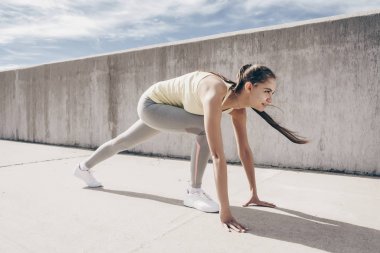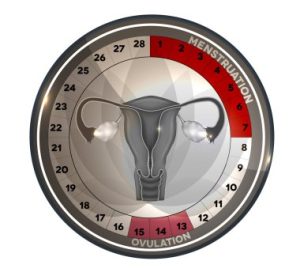
Can Exercise Start Your Period Early (6 Important Facts)
Can exercise start your period early? While it’s possible due to hormonal fluctuations, consistency in physical activity might regulate your cycle instead. Imagine this: the rhythmic thud of your sneakers hitting the pavement, the crisp air filling your lungs as you push your body to its limits. Suddenly, amidst the adrenaline rush, a subtle yet powerful sensation washes over you – a gentle reminder that your body is in sync with the symphony of nature. Could it be? Yes, indeed.
The relationship between exercise and menstruation has intrigued many, with anecdotal evidence suggesting a connection between physical activity and the timing of periods. The unexpected magic of exercise isn’t just about sculpting muscles and boosting endorphins; it holds the mystical ability to sway the tides of your menstrual cycle. Brace yourself for a journey where sweat meets serenity, and the quest for fitness intertwines with the enigmatic dance of hormones.

Can Exercise Start Your Period Early
Yes, Exercise can sometimes cause hormonal shifts that may lead to an earlier onset of menstruation, but individual responses vary widely.
Understanding the Connection
Numerous women wonder if exercise can jump-start their periods, especially when they’re eagerly awaiting or dreading its arrival. It’s a common query among those who closely monitor their menstrual cycles and participate in regular physical activities.
Exploring the Science
Researchers have investigated the impact of exercise on menstrual cycles, aiming to decipher the mechanisms behind any observed changes in timing. While concrete conclusions remain elusive, some studies suggest a potential link between intense physical exertion and alterations in menstrual patterns.
Potential Mechanisms
One proposed mechanism is the influence of exercise on hormone levels, particularly cortisol and estrogen, which play crucial roles in regulating the menstrual cycle. Intense or prolonged workouts could disrupt the delicate balance of these hormones, potentially triggering an earlier period.
The Role of Body Composition
Additionally, body composition may contribute to the relationship between exercise and menstruation. Individuals with lower body fat percentages, such as athletes or those engaging in rigorous training regimes, might experience alterations in their menstrual cycles due to hormonal fluctuations induced by exercise.
Understanding Menstrual Cycle
Overview of the menstrual cycle phases
The menstrual cycle is a complex, orchestrated series of events that occurs in the female body, typically lasting around 28 days, although variations are common. It is governed by a delicate interplay of hormones, primarily estrogen and progesterone, which are produced by the ovaries. The cycle can be divided into four main phases, each with distinct hormonal changes and physiological processes.
The first phase is the menstrual phase, which marks the beginning of the cycle and is characterized by the shedding of the uterine lining, resulting in menstruation. This phase typically lasts around 3 to 7 days. Following menstruation, the follicular phase begins. During this phase, the pituitary gland releases follicle-stimulating hormone (FSH), which stimulates the growth of ovarian follicles containing immature eggs. As these follicles grow, they produce estrogen, which causes the uterine lining to thicken in preparation for potential implantation of a fertilized egg.
Ovulation marks the midpoint of the menstrual cycle and occurs around day 14 in a 28-day cycle. It is triggered by a surge in luteinizing hormone (LH), which causes the mature follicle to rupture and release an egg from the ovary. This egg is then available for fertilization for about 12 to 24 hours. Following ovulation, the luteal phase begins. During this phase, the ruptured follicle transforms into a structure called the corpus luteum, which secretes progesterone.
Progesterone helps to maintain the thickened uterine lining and prepares the uterus for implantation of a fertilized egg. If fertilization does not occur, hormone levels decline, leading to the shedding of the uterine lining and the start of a new menstrual cycle. Understanding the menstrual cycle is crucial for reproductive health and fertility, as disruptions or irregularities in the cycle can indicate underlying health issues.

Normal duration of menstrual cycle
The normal duration of a menstrual cycle typically ranges from 21 to 35 days, counting from the first day of one period to the first day of the next. On average, most women have a cycle that lasts around 28 days. However, it’s essential to recognize that menstrual cycles can vary significantly from person to person and may even fluctuate slightly month to month within an individual. Factors such as stress, diet, exercise, and overall health can influence the length and regularity of the menstrual cycle. While variations are common, any significant deviation from the typical range might warrant a discussion with a healthcare provider to rule out any underlying issues.
Hormonal regulation of the menstrual cycle
The menstrual cycle is a complex interplay of hormones orchestrated by the intricate dance of estrogen and progesterone, both of which play pivotal roles in regulating this recurring physiological process in females. Estrogen, primarily secreted by the developing ovarian follicles, holds the spotlight in the initial phase of the menstrual cycle, known as the follicular phase. This hormone promotes the proliferation of the endometrial lining of the uterus, preparing it for potential embryo implantation. It also stimulates the production of cervical mucus, which facilitates the passage of sperm into the reproductive tract.
Additionally, estrogen triggers the release of luteinizing hormone (LH) and follicle-stimulating hormone (FSH) from the pituitary gland, crucial for ovulation—the release of a mature egg from the ovary. As estrogen levels peak, they signal the onset of ovulation, marking the transition to the second phase of the menstrual cycle—the luteal phase.
Progesterone, the hormone that takes center stage during the luteal phase. Secreted by the corpus luteum—a temporary endocrine structure formed from the remnants of the ovarian follicle post-ovulation—progesterone serves as a key player in maintaining the uterine lining conducive for embryo implantation and pregnancy. It promotes the secretion of glycogen-rich fluids in the endometrium, creating a nurturing environment for a potential embryo.
Progesterone also inhibits the contraction of uterine muscles, preventing premature contractions that could impede embryo implantation. Moreover, it stimulates the thickening of cervical mucus, creating a barrier to sperm entry into the uterus, thus minimizing the risk of fertilization during the latter part of the menstrual cycle. If fertilization does not occur, levels of estrogen and progesterone decline, signaling the shedding of the uterine lining—menstruation—and the beginning of a new menstrual cycle. However, if fertilization and implantation do occur, the developing embryo signals the corpus luteum to continue producing progesterone, thereby maintaining the uterine environment necessary for pregnancy.
Factors influencing menstrual cycle variations
The menstrual cycle, a complex interplay of hormones and physiological processes, can be influenced by a multitude of factors. Hormonal fluctuations, primarily orchestrated by the hypothalamus, pituitary gland, and ovaries, are central to the menstrual cycle’s rhythm. Stress, both physical and emotional, can disrupt this delicate balance, leading to irregularities or changes in cycle length. Diet and exercise also play pivotal roles; extremes in either can affect hormone levels, potentially altering menstrual patterns.
Environmental factors such as exposure to pollutants or changes in light exposure may further impact the cycle. Additionally, underlying health conditions, like polycystic ovary syndrome (PCOS) or thyroid disorders, can lead to irregularities. Moreover, medications, including contraceptives or certain antidepressants, can influence menstrual regularity. Overall, the menstrual cycle is highly sensitive to various internal and external influences, reflecting the intricate nature of the female reproductive system.
Exercise and Menstrual Cycle
Impact of exercise on hormonal balance
Exercise can significantly impact the menstrual cycle and hormonal balance in women. Regular physical activity has been shown to have positive effects on overall health, including menstrual health. During exercise, estrogen and progesterone levels may fluctuate, potentially leading to changes in the menstrual cycle. Estrogen levels can decrease during intense exercise, which may affect the regularity of periods.
However, moderate exercise has been associated with more regular menstrual cycles. Additionally, the influence of stress hormones like cortisol can play a role in menstrual health. High levels of cortisol due to stress can disrupt the delicate balance of reproductive hormones, potentially leading to irregular periods or even amenorrhea in extreme cases. Therefore, while exercise is generally beneficial for menstrual health, it’s important to strike a balance and manage stress levels to ensure hormonal equilibrium.
Studies suggesting a link between exercise and menstrual cycle alterations
Studies have indicated a compelling connection between exercise and alterations in the menstrual cycle, particularly among athletes. Research on athletes has often focused on the phenomenon of amenorrhea, where intense physical activity can lead to the absence of menstruation. This condition has been observed in various sports, ranging from endurance disciplines to aesthetic sports like gymnastics. These findings highlight the complex interplay between physical activity levels and hormonal regulation, emphasizing the importance of understanding and managing the impact of exercise on reproductive health.
Mechanisms through which exercise might affect menstruation
Exercise can influence menstruation through various physiological mechanisms, underscoring the intricate relationship between physical activity and the menstrual cycle. One key factor is the impact of exercise on hormonal levels. Regular physical activity can modulate hormone secretion, such as reducing levels of estrogen and progesterone, which are crucial for regulating the menstrual cycle. This alteration in hormonal balance might affect the timing and intensity of menstruation, potentially leading to changes in cycle length or the amount of menstrual flow.
Additionally, exercise can influence body composition and overall metabolism, leading to changes in adipose tissue distribution and insulin sensitivity. Since adipose tissue plays a role in hormone metabolism and production, alterations in body composition induced by exercise can indirectly impact menstrual function. Moreover, exercise can affect stress levels and the hypothalamic-pituitary-adrenal (HPA) axis activity. Intense or prolonged physical activity can trigger stress responses in the body, leading to the release of cortisol and other stress hormones, which may disrupt normal hormonal signaling pathways involved in menstruation.
Conversely, moderate exercise has been shown to reduce stress levels and promote relaxation, potentially exerting a positive influence on menstrual regularity. Furthermore, exercise can enhance blood circulation and oxygen delivery throughout the body, including the reproductive organs. Improved blood flow to the uterus and ovaries may support healthy menstrual function by facilitating the delivery of oxygen and nutrients necessary for normal hormonal production and tissue maintenance.
However, it’s essential to note that the effects of exercise on menstruation can vary widely among individuals and may depend on factors such as exercise intensity, duration, frequency, and individual physiological characteristics. While regular, moderate exercise is generally associated with positive effects on menstrual health, excessive exercise or sudden increases in activity levels can lead to menstrual irregularities or even amenorrhea in some cases, highlighting the importance of striking a balance between exercise and overall health.

Early Menstruation: Causes and Symptoms
Definition and characteristics of early menstruation
Early menstruation, also known as precocious puberty or early onset puberty, refers to the occurrence of menstruation before the age of 11. This phenomenon is characterized by the premature development of secondary sexual characteristics such as breast development and pubic hair growth. Early menstruation is influenced by various factors including genetics, nutrition, environmental factors, and socio-economic status.
Girls experiencing early menstruation may face both physical and emotional challenges, including increased risk of certain health issues like breast cancer and psychological stress due to social and emotional immaturity compared to peers. Additionally, early menstruation can impact educational and social development, as girls may struggle to cope with the physical and emotional changes while navigating adolescence. Early identification and appropriate management are crucial to address potential health concerns and provide support for affected individuals.
Possible causes of early menstruation
Early menstruation, also known as precocious puberty, can stem from various factors, predominantly hormonal imbalances. Hormones like estrogen and progesterone play pivotal roles in regulating the menstrual cycle, and disruptions in their levels can trigger menstruation earlier than usual. Stress can also be a significant contributor, as heightened cortisol levels can disrupt the delicate hormonal balance necessary for regular menstrual cycles.
Furthermore, fluctuations in weight, whether significant gain or loss, can impact hormone production and consequently lead to early menstruation. These factors collectively highlight the complex interplay between hormonal regulation, stress, and physical changes in the body, all of which can influence the timing of menstruation.
Symptoms associated with early menstruation
Early menstruation, also known as precocious puberty, can manifest with several symptoms that may signal the onset of puberty before the typical age range. One notable symptom is changes in menstrual flow, where girls experience their first period earlier than usual, often before the age of 11. This premature menstruation can be accompanied by irregular cycles and varying flow patterns.
Additionally, premenstrual symptoms may occur earlier than expected, such as mood swings, bloating, breast tenderness, and cramps, impacting girls’ physical and emotional well-being. These symptoms may not only be distressing but can also pose challenges in managing menstruation at a younger age, necessitating early education and support.
The Relationship Between Exercise and Early Menstruation
Research evidence supporting the link between exercise and early menstruation
Research provides compelling evidence supporting the correlation between exercise and delayed menarche, the onset of menstruation in females. Numerous studies have demonstrated that increased physical activity levels are associated with alterations in hormonal profiles, specifically decreased levels of estrogen, which can delay the onset of menarche.
Regular exercise promotes a lower percentage of body fat, leading to decreased levels of leptin, a hormone involved in regulating reproductive function. Additionally, intense physical activity can disrupt the delicate balance of hormones necessary for menstruation, thereby delaying its onset. Moreover, exercise-induced stress on the body can also contribute to delayed menarche by affecting the hypothalamic-pituitary-adrenal axis. Overall, these findings highlight the significant role that exercise plays in influencing the timing of menarche, emphasizing the importance of maintaining a balanced approach to physical activity during adolescence.
Types of exercise more likely to influence menstrual cycle timing
The relationship between exercise and menstrual cycle timing is complex and multifaceted, influenced by various factors such as intensity, duration, frequency, and individual physiological differences. Generally, moderate-intensity aerobic exercises like walking, cycling, or swimming are more likely to positively influence menstrual cycle regularity. These exercises help maintain a healthy body weight and reduce stress levels, both of which are crucial for regulating hormonal balance and ensuring a regular menstrual cycle.
Additionally, activities that focus on flexibility and relaxation, such as yoga or Pilates, can also have a positive impact on menstrual cycle timing by reducing cortisol levels and promoting relaxation. However, it’s essential to note that excessive exercise or intense training regimes, particularly in endurance sports like marathon running or competitive cycling, can disrupt the menstrual cycle and lead to irregularities or even amenorrhea (absence of menstruation).
This is often due to the body’s increased production of cortisol, a stress hormone, which can suppress reproductive hormones and interfere with ovulation. Therefore, striking a balance between exercise intensity and duration is key to promoting a healthy menstrual cycle. Additionally, individual differences play a significant role, so it’s essential for women to listen to their bodies and adjust their exercise routines accordingly, especially during times of hormonal fluctuations.

Managing Menstrual Cycle Variations Related to Exercise
Importance of maintaining a balanced exercise routine
Managing menstrual cycle variations related to exercise is crucial for women’s overall health and well-being. Engaging in regular physical activity offers numerous benefits, but it’s essential to maintain a balanced exercise routine to support hormonal balance and menstrual regularity. Sudden increases in exercise intensity or volume can disrupt the menstrual cycle, leading to irregularities or even amenorrhea.
Conversely, excessive exercise can exacerbate menstrual symptoms like cramping and fatigue. By incorporating a mix of cardiovascular, strength training, and flexibility exercises while allowing for adequate rest and recovery, women can better regulate their menstrual cycles and alleviate associated symptoms. Prioritizing a balanced approach to exercise not only supports reproductive health but also promotes overall physical and mental wellness.
Strategies for minimizing the risk of irregularity in menstruation
Minimizing the risk of irregularity in menstruation involves a multifaceted approach that prioritizes holistic well-being. Integrating rest days into the workout schedule is crucial, allowing the body adequate time to recover and preventing excessive strain. Balancing high-intensity workouts with relaxation exercises such as yoga promotes hormonal equilibrium and reduces stress levels, which can positively impact menstrual health.
Additionally, consulting healthcare professionals for personalized advice ensures tailored strategies to mitigate the risk factors specific to an individual’s physiology and lifestyle. By adopting these proactive measures, individuals can safeguard their menstrual health and promote overall wellness.
Frequently Asked Questions (FAQ) about Can Exercise Start Your Period Early
Q1. Does exercise really have an impact on the timing of my period?
A. Yes, it can. Exercise affects hormone levels in your body, which can influence your menstrual cycle.
Q2. How does exercise affect my menstrual cycle?
A. Intense or prolonged exercise can alter hormone levels, specifically decreasing estrogen levels, which may lead to changes in your menstrual cycle, including an earlier period.
Q3. Can exercise make my period start earlier than usual?
A. Yes, for some people. Engaging in rigorous physical activity can sometimes trigger an early period due to hormonal fluctuations.
Q4. What types of exercise are most likely to affect my period?
A. High-intensity exercises such as running, weightlifting, or endurance training are more likely to impact your menstrual cycle compared to moderate or low-intensity activities.
Q5. How soon after starting a new exercise routine might I notice changes in my period?
A. It varies from person to person, but some individuals may notice changes within a few weeks of starting a new exercise regimen.
Q6. Is it normal for my period to be irregular when I’m exercising regularly?
A. Yes, it’s not uncommon for periods to become irregular when starting a new exercise routine or increasing the intensity of workouts. However, if you experience persistent irregularities, it’s wise to consult a healthcare provider.
Q7. Can exercise help regulate my period if it’s irregular?
A. In some cases, yes. Regular exercise, especially moderate-intensity activities like walking or yoga, can help regulate hormone levels and improve overall menstrual health.
Q8. Are there any other factors besides exercise that can cause an early period?
A. Yes, factors like stress, changes in weight, diet, and certain medical conditions can also influence the timing of your period.
Q9. Should I be concerned if exercise consistently causes my period to start early?
A. If you’re experiencing significant changes in your menstrual cycle or if early periods persist despite adjustments to your exercise routine, it’s advisable to seek advice from a healthcare professional to rule out any underlying issues.
Q10. How can I manage my menstrual cycle while exercising regularly?
A. Monitoring your cycle, maintaining a balanced diet, staying hydrated, and listening to your body’s signals are essential. If you’re experiencing any concerning changes, consider adjusting your exercise routine and consult with a healthcare provider for guidance.
Conclusion
In conclusion, while there is some anecdotal evidence suggesting that exercise can influence the timing of menstruation, the scientific consensus remains inconclusive. While moderate exercise is generally beneficial for overall health, extreme or excessive physical activity may disrupt hormonal balance, potentially affecting menstrual cycles.
However, individual responses to exercise vary greatly, and many factors beyond physical activity alone can influence menstrual patterns. Further research is needed to better understand the complex interplay between exercise, hormones, and menstrual health. In the meantime, it’s important for individuals to listen to their bodies, maintain a balanced lifestyle, and consult healthcare professionals if experiencing irregularities in their menstrual cycles.